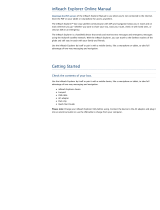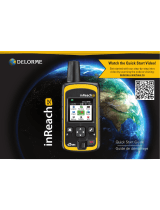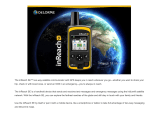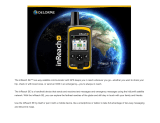
Table of contents
Getting started................................................................ 1
Device Overview......................................................................... 1
Mounting and Powering the Device in Your Vehicle................... 1
Turning the device on or off........................................................ 1
Acquiring GPS signals................................................................ 2
Home Screen.............................................................................. 2
Opening an App..................................................................... 2
Adding Shortcuts to the Home Screen.................................. 2
Viewing Notifications.............................................................. 2
Status bar icons..................................................................... 2
Using the Touchscreen............................................................... 2
Adjusting the screen brightness................................................. 2
Vehicle Profiles............................................................... 2
Car Profile................................................................................... 3
Adding a vehicle profile...............................................................3
Switching the Vehicle Profile...................................................... 3
Editing a vehicle profile............................................................... 3
Driver awareness features and alerts........................... 3
Enabling or disabling audible driver alerts.................................. 3
Red light and speed cameras..................................................... 3
Street Navigation............................................................ 3
Routes........................................................................................ 3
Starting a route........................................................................... 4
Starting a route by using the map.......................................... 4
Going home........................................................................... 4
Editing your home location................................................ 4
Your route on the map................................................................ 4
Active lane guidance.............................................................. 4
Viewing turns and directions.................................................. 4
Viewing the Entire Route on the Map.................................... 5
Arriving at your destination......................................................... 5
Parking Near Your Destination.............................................. 5
Changing Your Active Route...................................................... 5
Adding a location to your route.............................................. 5
Shaping your route.................................................................5
Taking a detour...................................................................... 5
Changing the route calculation mode.................................... 5
Stopping the route...................................................................... 5
Using Suggested Routes............................................................ 5
Avoiding Delays, Tolls and Areas............................................... 5
Avoiding traffic delays on your route...................................... 5
Avoiding toll roads..................................................................6
Avoiding toll stickers.............................................................. 6
Avoiding road features........................................................... 6
Avoiding environmental zones............................................... 6
Custom avoidances............................................................... 6
Avoiding a road................................................................. 6
Avoiding an area............................................................... 6
Disabling a custom avoidance.......................................... 6
Deleting custom avoidances............................................. 6
Finding and saving locations........................................ 6
Points of Interest......................................................................... 6
Navigating to a Garmin Explore Location.............................. 7
Finding a location by category............................................... 7
Searching within a category.............................................. 7
Finding Campsites................................................................. 7
Finding Motor Home parks................................................ 7
Finding Ultimate Campgrounds points of interest.................. 7
Finding Motor Home services................................................ 7
Finding National Parks........................................................... 7
Exploring National Park Features and Amenities............. 7
Finding iOverlander™ points of interest.................................7
Finding HISTORY® points of interest.................................... 7
Foursquare
.............................................................................7
Searching Foursquare points of interest........................... 7
TripAdvisor®.......................................................................... 8
Finding TripAdvisor points of interest................................ 8
Navigating to points of interest within a venue...................... 8
Exploring a venue............................................................. 8
Finding a location using the search bar...................................... 8
Finding an address..................................................................... 8
Location Search Results............................................................. 8
Location Search Results on the Map..................................... 8
Changing the search area.......................................................... 9
Custom points of interest............................................................ 9
Installing POI Loader............................................................. 9
Finding custom POIs..............................................................9
Parking........................................................................................9
Finding Parking Near Your Current Location......................... 9
Understanding Parking Colours and Symbols....................... 9
Search tools................................................................................ 9
Finding a junction................................................................... 9
Finding a town........................................................................9
Finding a location using coordinates..................................... 9
Viewing history............................................................................9
Clearing the list of recently found places............................... 9
Viewing current location information........................................... 9
Finding emergency services and fuel.................................... 9
Getting directions to your current location........................... 10
Adding a shortcut...................................................................... 10
Removing a shortcut............................................................ 10
Saving Locations...................................................................... 10
Saving a location..................................................................10
Saving your current location................................................ 10
Editing a favourite location................................................... 10
Assigning categories to a saved location............................. 10
Deleting a favourite location................................................ 10
Using the Street Map.................................................... 10
Map Tools................................................................................. 10
Viewing a map tool...............................................................10
Up ahead.................................................................................. 11
Viewing upcoming locations.................................................11
Customising the up ahead categories................................. 11
Warning and alert symbols....................................................... 11
Restriction Warnings............................................................ 11
Road condition warnings......................................................11
Alerts.................................................................................... 11
Trip information......................................................................... 11
Viewing trip data from the map............................................ 11
Customising the trip data fields....................................... 11
Viewing the trip information page........................................ 11
Viewing the trip log...............................................................11
Resetting trip information..................................................... 11
Viewing upcoming traffic........................................................... 11
Viewing traffic on the map....................................................12
Searching for traffic incidents...............................................12
Customising the map................................................................ 12
Customising the map layers.................................................12
Changing the map data field................................................ 12
Changing the map perspective............................................ 12
Off-Road Navigation..................................................... 12
Garmin Explore......................................................................... 12
Logging in to a Garmin Explore Account............................. 12
Map...................................................................................... 12
Downloading Garmin Explore Maps................................12
Filtering Map Data........................................................... 12
Garmin Explore Map Settings......................................... 13
Creating a Waypoint........................................................13
Create a Route................................................................ 13
Table of contents i



























